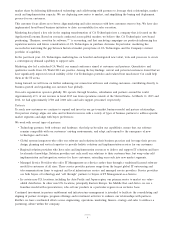Computer Associates 2015 Annual Report Download - page 21
Download and view the complete annual report
Please find page 21 of the 2015 Computer Associates annual report below. You can navigate through the pages in the report by either clicking on the pages listed below, or by using the keyword search tool below to find specific information within the annual report.
further because, in the event of a system-wide failure, it may be difficult to determine which product is at fault. As a result,
we may be harmed by the failure of another supplier’s products. As a result of the foregoing, we could experience:
• Loss of or delay in revenue and loss of market share;
• Loss of customers, including the inability to obtain repeat business with existing key customers;
• Damage to our reputation;
• Failure to achieve market acceptance;
• Diversion of development resources;
• Remediation efforts that may be required;
• Increased service and warranty costs;
• Legal actions by customers or government authorities against us that could, whether or not successful, be costly,
distracting and time-consuming;
• Increased insurance costs; and
• Failure to successfully complete service engagements for product installations and implementations.
Consequently, the discovery of errors in our Products after delivery could materially adversely affect our business, financial
condition, operating results and cash flow.
Failure to protect our intellectual property rights and source code would weaken our competitive position.
Our future success is highly dependent upon our proprietary technology, including our software and our source code for
that software. Failure to protect such technology could lead to the loss of valuable assets and our competitive advantage. We
protect our proprietary information through the use of patents, copyrights, trademarks, trade secret laws, confidentiality
procedures and contractual provisions. Notwithstanding our efforts to protect our proprietary rights, policing unauthorized
use or copying of our proprietary information is difficult. Unauthorized use or copying occurs from time to time and
litigation to enforce intellectual property rights could result in significant costs and diversion of resources. Moreover, the
laws of some foreign jurisdictions do not afford the same degree of protection to our proprietary rights as do the laws of
the United States. For example, for some of our products, we rely on ‘‘shrink-wrap’’ or ‘‘click-on’’ licenses, which may be
unenforceable in whole or in part in some jurisdictions in which we operate. In addition, patents we have obtained may be
circumvented, challenged, invalidated or designed around by other companies. If we do not adequately protect our
intellectual property for these or other reasons, our business, financial condition, operating results and cash flow could be
materially adversely affected. Refer to Part I, Item 1, ‘‘Business — (c) Narrative Description of the Business — Intellectual
Property,’’ for additional information.
Failure to renew large license agreement transactions on a satisfactory basis could materially adversely affect
our business, financial condition, operating results and cash flow.
Our core customers are large enterprises with multi-year enterprise license agreements each of which involves substantial
aggregate fee amounts. These customers have no contractual obligation to purchase additional solutions and renewal rates
may decline or fluctuate as a result of a number of factors, including the level of customer satisfaction with our solutions or
customer support, customer budgets and the pricing of our solutions as compared with the solutions offered by our
competitors, any of which may cause our revenue to grow more slowly than expected, if at all. The failure to renew those
transactions in the future, or to replace those enterprise license agreements with new transactions of similar scope, on terms
that are commercially attractive to us, could materially adversely affect our business, financial condition, operating results
and cash flow.
Certain software that we use in our products is licensed from third parties and, for that reason, may not be
available to us in the future, which has the potential to delay product development and production or cause us
to incur additional expense, which could materially adversely affect our business, financial condition, operating
results and cash flow.
Some of our solutions contain software licensed from third parties. Some of these licenses may not be available to us in the
future on terms that are acceptable to us or allow our products to remain competitive. The loss of these licenses or the
inability to maintain any of them on commercially acceptable terms could delay development of future products or the
enhancement of existing products. We may also choose to pay a premium price for such a license in certain circumstances
18
























